This week James Dignan examines the works Barry Brickell, Eliot Coates, Jane Crisp and Julie Greig.
His Own Steam, Barry Brickell (Dunedin Public Art Gallery)
Brickell's art has been as influential over the course of his long career as it is impressive in its own right. The substantial exhibition ''His Own Steam'' is a unique opportunity to see an impressive overview of his work.
The exhibition features more than 100 items, many of them from the collection of the Dowse Art Museum, which curated this travelling show.
The works mix influences from east Asian master craftsmanship through traditional Melanesian and Polynesian styles, all combined with the potter's own unique humour and inventiveness.
There is a great warmth in Brickell's giant pots, many of which take on surreal zoomorphic forms, or use combinations of sensual curves and precise geometry.
Nearby sits smaller, utilitarian ware, albeit with the artist's deft touch and eye, exemplified by the single incongruous drop of glaze on the otherwise pristine Large red bowl.
Also on display are a series of fine ceramic mural pieces, among them the show's unheralded star, the 14 railway stations of the cross, Some stations on the Main Trunk Line, which draw parallels between Christ's journey to Calvary and a rail journey through the North Island.
New Works (Milford Galleries Dunedin)
Of the five artists, only Hannah Kidd has exhibited to any extent in Dunedin before. Her plate-and-frame metallic animal sculptures excellently capture the vitality of their subjects.
This show's impressive racing greyhounds neatly continue on from Kidd's thoroughbred racehorse sculptures seen recently at the Milford.
Johnny Turner provides the other sculptural element to the show, his fine, touch-tempting marble and granite forms fooling the eye with their crystalline textures and sheer smooth surfaces.
Eliot Coates and Krystie Wade produce paintings which form an odd symbiosis.
Coates' attractive meditative monochromatic landforms slip in and out of a heavily glazed mist, slowly passing from the real to the abstract.
Wade's gaudy abstract expressionist works approach the same point from the opposite direction.
Her confident strokes resolve into landscape with each repeated view, the combination of blocks and textures proving as enigmatic as Coates' mists.
Teresa H. R. Lane's work completes the exhibition.
Her scenes, featuring builders engaged in their work, have a half-finished air, presented in line drawing and coloured block against wood grain.
Yet this incompleteness creates an attraction and mystery to the work, while simultaneously revealing the artist's compositional and drawing skills.
Lande, Leather, Metal & Feather, Jane Crisp and Julie Greig (The Arrtist's Room)
Though the two painters' representational images differ in their style and subjects, they sit well alongside each other.
Julie Greig's strong oil paintings capture the spirit of the land in which they are set.
The high-country farmers and animals come to life in her images against a backdrop of the dry Mackenzie hills.
These are real people in a real setting, depicted with honesty and love.
Texture is boldly drawn, but where delicacy is needed it is well-used, especially in fine portrait studies of working horses such as Montuzza.
Jane Crisp's work, while also finely representational, has a whimsical, gently surreal element.
Crisp's acrylic paintings and graphite drawings feature meticulously depicted bird life in vaguely preposterous settings - a kiwi bathing in a gravy boat, or another kiwi being squashed into a sugar bowl by a butterfly.
The detail is exquisite, whether it be the sheen on the pewter or the veins on the butterfly's wings.
The works are brought even further to life by the deliberate and effective use of heavy ornate wooden framing, a surround which complements the images perfectly.








![Untitled (c. mid 1990s, [pink 3]), by Martin Thompson, 415mm×590mm. Photo: courtesy of Brett...](https://www.odt.co.nz/sites/default/files/styles/odt_landscape_small_related_stories/public/story/2024/02/untitled_pink_3.jpg?itok=Q0aQrc9o)



